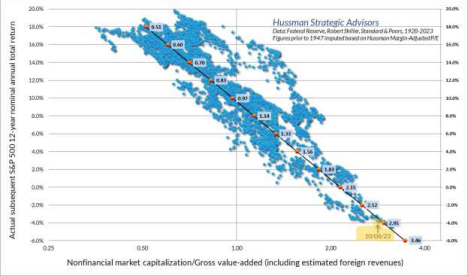Executive Summary
Some investors think “valuation” is a dirty word and is some type of market timing indicator. On the contrary, valuation determines whether prices are reasonable based upon historical standards. Economist Dr. John Hussman has done extensive research on the accuracy of valuation methodologies, and the one he determined to be the most accurate currently indicates average annual future returns for the next twelve years of -4%. Part of his explanation of valuations is:
“Rich valuations don’t imply immediate market losses. I can’t repeat that often enough… The only way that valuations were able to reach the extremes of 1929, 2000 and today was by plowing through every lesser extreme, undaunted. Unfortunately, the deferral of consequences should not be confused with the absence of consequences.”
Investor psychology can cause speculators to drive markets to extremes. And while valuations do not predict the time of future losses, they do indicate what future returns should be expected based on current fundamentals. Please see The Details for a more thorough discussion.
Please continue to The Details for more of my analysis.
“I didn’t get rich by buying stocks at a high price-earnings multiple in the midst of crazy speculative booms, and I’m not going to change.”
–Charlie Munger
The Details
To some investors…or should I say speculators, “valuation” is a dirty word. They consider anyone referencing valuations during a speculative bull market to be a “bear.” Some speculators believe one who states the market is overvalued by “x%” means one is calling for the market to immediately fall by that percent. That is not how market cycles work. Calculating the valuation of the market is merely determining if current prices have deviated from what would be considered “reasonable”, based upon historical standards. A stock should be worth the present value of a long-term stream of cash produced by that company. However, it is rare that stock prices remain at that particular level.
Market cycles are driven by investor psychology. In bull markets, investors become enamored by rising prices. Soon prices are driven higher by circular thinking. Stocks are going up in price, so one should buy stocks. This leads to more buying which pushes prices even higher. Valuations are completely abandoned, even scoffed at. This behavior leads to FOMO or the fear of missing out. As investors hear stories of their family’s and neighbors’ easy successes in the market, they too must participate for fear of being left behind. This activity leads to bubble valuations in the
market. Questioning such behavior based upon valuations could result in being labeled a “perma bear.”
At this point in the cycle, speculators begin justifying bubble valuations. In the 1920’s it was considered a “New Era” where old methodologies no longer applied. In the 1990’s, speculators justified actions by saying there was a “New Economy” where technological developments had changed the game and old principles no longer were relevant.
Economist, Dr. John Hussman recently wrote in his monthly Comment, “Bubble extremes lead investors to forget history. Investors look back on the advance of the preceding years, and see only that high valuations were followed by even higher valuations; that every setback was followed by a resumption of glorious returns. They conclude that valuations are worthless. They imagine that the returns they enjoyed from the point of rich valuations to the point of extreme valuations are actually returns that they will keep over the complete cycle. Worse, like economist Irving Fisher catastrophically proposed in 1929, many investors insist that market cycles no longer exist, and that valuations will maintain a ‘permanently high plateau.’
Buckle up.”
Valuations are not a timing mechanism. They do not indicate a correction is imminent. However, an accurate valuation methodology provides a good depiction of what future 10-12 year average returns will look like. Eventually markets “revert to the mean.” Said differently, eventually investors realize markets are priced insanely and become fearful. This realization leads to selling stocks. Soon selling begets more selling, and the bubble begins to deflate. When panic arrives, investors attempt to dump stocks as soon as possible before prices fall any further. At this point it is like someone yelling “fire” in a movie theater with one exit. In the end prices have fallen so far, they are considered undervalued. Yet, at this point no one wants to touch stocks for fear they will fall further.
The best valuation methodologies are highly correlated with future actual results. In other words, did the valuation methodology calculated 10 years ago accurately project average returns over the following 10-year period? If not, can the difference be explained by the present market cycle? Dr. Hussman has done extensive research calculating accurate valuation methodologies. He has determined that the methodology most correlated with actual future results is “Nonfinancial market capitalization / Gross value-added (including estimated foreign revenues)”. Or summarized in English, Price / Revenue.
The graph below from Dr. Hussman plots actual 12-year future returns based upon the valuation level determined using the method explained above, for the period 1928 to present. The arrow (I have highlighted in yellow) indicates the level of valuation on 10/6/2023. The current valuation reading indicates an average annual future 12-year return of -4%!

Dr. Hussman’s research indicates this methodology has the highest possibility of accurately forecasting future 12-year returns of all the approaches he has explored. Of course, there is no way to measure the accuracy of this calculation until the next 12 years pass. Again, this calculation does not indicate when the correction should begin. However, as I have written previously, I believe the bear market began in January 2022. The purpose of a bear market is to burn off the bubble excesses achieved during the prior bull market. Since the bear market has begun, investors have entered the danger zone.
Dr. Hussman wrote, “One of the often-overlooked features of reliable valuation measures is that they are highly informative not only about long-term returns, but also about the likely depth of market losses over the completion of a given market cycle. Emphatically, these losses do not necessarily emerge immediately. Rich valuations don’t imply immediate market losses. I can’t repeat that often enough. If they did, we would never observe bubble valuations. The only way that valuations were able to reach the extremes of 1929, 2000 and today was by plowing through every lesser extreme, undaunted.
Unfortunately, the deferral of consequences should not be confused with the absence of consequences. The completion of nearly every market cycle across history has brought projected S&P 500 total returns to the higher of a) their historically run-of-the-mill 10% norm or b) 2% above prevailing Treasury bond yields. At present, that would require a market loss on the order of -63% in the S&P 500. That’s not a forecast, but it certainly is a historically-consistent estimate of the potential downside risk created by more than a decade of Fed-induced yield seeking speculation.”
“Valuation” is not a dirty word, and investors would be wise to understand its meaning and implications for the future. The market cycle has turned, and investors have entered the danger zone. Dr. Hussman has provided the research to highlight the results of current bubble prices. Understanding what this means could save investors from significant unwanted losses. Losses which might not immediately bounce. As Mark Twain said, “History never repeats itself, but it does often rhyme.”
The S&P 500 Index closed at 4,328, up 0.4% for the week. The yield on the 10-year Treasury Note fell to 4.63%. Oil prices rose to $88 per barrel, and the national average price of gasoline according to AAA dropped to $3.60 per gallon.
I always like to take a moment of my day to be grateful for the life I life and to think of new ways to help those around me.
With that being said, I’d like to invite you to join me in supporting St. Jude’s Children’s Research Hospital.
I am a St. Jude Hero! I have chosen to run for a reason bigger than myself by fundraising for the kids and families at St. Jude. I am training to cross the finish line on race day and with your donation, we can cross the fundraising finish line together because the money you donate helps find a cure for childhood cancer.
© 2023. This material was prepared by Bob Cremerius, CPA/PFS, of Prudent Financial, and does not necessarily represent the views of other presenting parties, nor their affiliates. This information should not be construed as investment, tax or legal advice. Past performance is not indicative of future performance. An index is unmanaged and one cannot invest directly in an index. Actual results, performance or achievements may differ materially from those expressed or implied. All information is believed to be from reliable sources; however we make no representation as to its completeness or accuracy.
Securities offered through First Heartland Capital, Inc., Member FINRA & SIPC. | Advisory Services offered through First Heartland Consultants, Inc. Prudent Financial is not affiliated with First Heartland Capital, Inc.

